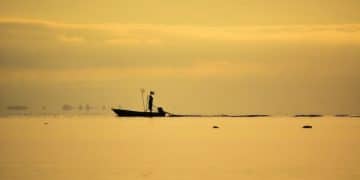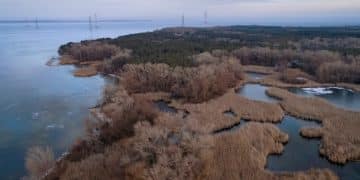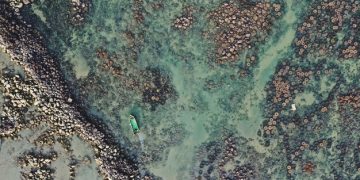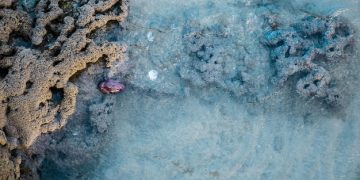Coastal Conservation: Protecting US Species & Habitats
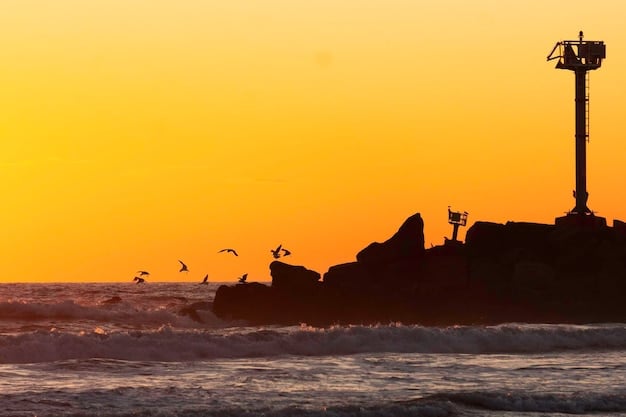
Coastal conservation efforts are critical interventions combining scientific research, policy implementation, and community engagement to protect endangered species and vital habitats along US coastlines from escalating environmental threats.
The delicate balance of coastal ecosystems is facing unprecedented challenges, from climate change to human development. Understanding and implementing effective coastal conservation efforts: protecting endangered species and habitats is more vital than ever for safeguarding the ecological integrity and biodiversity of our precious coastlines.
The escalating threats to coastal ecosystems
Coastal ecosystems, including estuaries, wetlands, beaches, and coral reefs, are among the most biodiverse and productive environments on Earth. They provide essential services such as storm protection, water filtration, and nursery grounds for numerous species. However, these vital areas are increasingly under immense pressure from a multitude of human-induced and environmental threats.
Coastal development and habitat loss
Human population growth, particularly in coastal zones, leads to extensive development. This often involves converting natural coastal habitats into residential areas, commercial properties, and infrastructure. This direct habitat destruction is a primary driver of biodiversity loss. Marshes are filled, dunes are leveled, and beaches are armored, disrupting natural processes and eliminating critical living spaces for countless plants and animals.
- Urbanization and infrastructure expansion result in irreversible habitat destruction.
- Dredging for navigation channels and ports alters natural sediment transport and water flow.
- Recreational activities, if unregulated, can disturb sensitive nesting and breeding sites.
Pollution and water quality degradation
Pollution from various sources gravely impacts coastal waters and marine life. Runoff containing agricultural fertilizers, pesticides, and urban chemicals enters coastal waters, leading to eutrophication and harmful algal blooms that deplete oxygen, creating “dead zones.” Plastic pollution is another pervasive issue, with microplastics and larger debris entering the food web and causing physical harm to marine animals.
- Agricultural runoff introduces excess nutrients, fueling algal blooms.
- Industrial discharges release heavy metals and toxic chemicals into coastal ecosystems.
- Plastic waste poses entanglement and ingestion risks to marine mammals, birds, and fish.
Climate change exacerbates many existing threats. Rising sea levels inundate low-lying coastal areas, leading to habitat migration or loss for species unable to adapt quickly. Ocean acidification, a consequence of increased CO2 absorption by the oceans, threatens shell-forming organisms like corals and shellfish, disrupting entire food webs. More frequent and intense storms increase erosion and physical damage to coastal habitats.
Overfishing and unsustainable harvesting practices deplete fish stocks and disrupt marine food webs. The use of destructive fishing gear, such as bottom trawls, can damage sensitive seafloor habitats like coral reefs and seagrass beds. These pressures collectively weaken the resilience of coastal ecosystems, making them more vulnerable to collapse and diminishing their capacity to support diverse life.
Invasive species and disease
The introduction of non-native species, often through ballast water from ships or aquaculture, can outcompete native species for resources, disrupt food webs, and introduce new diseases. These invasive species can drastically alter ecosystem structure and function, sometimes leading to the decline or extinction of native populations. Diseases, amplified by warmer waters and weakened marine immune systems, also pose significant threats to coral, fish, and shellfish populations.
Understanding these intertwined threats is the first step towards effective conservation. Addressing them requires a multifaceted approach that combines scientific research, policy action, and community engagement to build resilient coastal ecosystems for future generations. The complexity of these issues demands integrated solutions that consider the interconnectedness of land, water, and marine life.
Key strategies for effective coastal conservation
Effective coastal conservation efforts: protecting endangered species and habitats require a comprehensive and adaptive approach that integrates various strategies. These strategies aim to mitigate existing threats, restore damaged ecosystems, and enhance the resilience of coastal areas against future challenges. The most successful initiatives often involve collaboration among government agencies, non-profit organizations, local communities, and scientific institutions.
Establishing and managing marine protected areas (MPAs)
Marine Protected Areas (MPAs) are designated zones where human activities are restricted to protect marine life and habitats. These areas can range from highly protected “no-take” zones, where all fishing and extraction are prohibited, to multiple-use MPAs that allow sustainable activities. MPAs serve as critical refuges for endangered species, allowing populations to recover and spill over into surrounding areas, benefiting fisheries.
The establishment of MPAs requires careful scientific planning to identify biodiversity hotspots, critical habitats, and migration corridors. Effective management involves regular monitoring, enforcement of regulations, and engagement with local stakeholders, including fishers and tourism operators, to ensure compliance and support. Public awareness campaigns are also essential to highlight the value of these protected zones.
Restoration of degraded habitats
Active restoration projects focus on repairing ecosystems that have been damaged or destroyed. This includes replanting mangroves and seagrass beds, rebuilding oyster reefs, and restoring sand dunes. These efforts not only bring back lost habitat but also enhance natural coastal defenses, improve water quality, and create nursery grounds for fish and shellfish. Restoration is often a labor-intensive process, requiring significant resources and long-term commitment.
- Mangrove restoration: Replanting mangrove forests helps stabilize coastlines and provides crucial habitat.
- Seagrass bed recovery: Restoring seagrass improves water clarity and supports diverse marine life.
- Oyster reef rebuilding: Oyster reefs filter water and create complex habitats for fish and invertebrates.
- Dune stabilization: Rebuilding dunes with native vegetation protects against erosion and storm surge.
Innovative techniques, such as coral gardening and artificial reef deployment, are also being employed to aid recovery in severely degraded areas. These projects often involve propagating corals in nurseries and then outplanting them onto damaged reefs, or creating new structures from materials like concrete or steel to provide immediate habitat. While effective, restoration efforts are costly and highlight the importance of proactive preventative measures.
Policy and legal frameworks
Robust policies and legal frameworks are fundamental to guiding conservation efforts. This includes enacting and enforcing laws that regulate coastal development, pollution discharge, and fishing practices. Zoning regulations can designate areas for specific uses, separating sensitive habitats from high-impact activities. International agreements also play a role in addressing transboundary issues like migratory species protection and marine pollution.
Sustainable fisheries management, guided by scientific assessments, sets catch limits, regulates gear types, and establishes fishing seasons to prevent overexploitation. Land-use planning, extended to consider coastal impacts, aims to minimize runoff and habitat fragmentation. These frameworks often require strong political will and effective governance to ensure compliance and long-term effectiveness.
Community engagement and education
Engaging local communities is paramount for the success of any conservation initiative. When communities understand the value of healthy coastal ecosystems and feel empowered to participate in conservation, projects are more likely to be sustainable. Educational programs raise awareness about environmental issues and foster a sense of stewardship among residents, especially younger generations.
Citizen science programs allow volunteers to collect valuable data, contributing to scientific research and monitoring efforts. Local conservation groups play a crucial role in organizing clean-up events, advocating for policy changes, and implementing grassroots conservation projects. By fostering a connection between people and their coastal environments, community engagement builds a foundation for long-term conservation success.
Protecting endangered coastal species
The urgency to safeguard specific endangered coastal species is a driving force behind many coastal conservation efforts: protecting endangered species and habitats. These species often serve as indicators of ecosystem health, and their decline signals broader environmental problems. Conservation strategies for these species vary, but generally involve a combination of habitat protection, direct intervention, and scientific research.
Sea turtles: Navigating a perilous future
All seven species of sea turtles are listed as endangered or threatened. They face threats from habitat loss (nesting beaches and foraging grounds), incidental capture in fishing gear (bycatch), plastic pollution, and climate change affecting nesting success due to rising sand temperatures. Conservation efforts include protecting nesting beaches from development and artificial light, implementing Turtle Excluder Devices (TEDs) in fishing nets, and rehabilitation centers for injured turtles.
- Beach protection: Safeguarding nesting sites from human disturbance and erosion.
- Bycatch reduction: Mandating TEDs and advocating for sustainable fishing practices.
- Light pollution mitigation: Encouraging “turtle-friendly” lighting near nesting beaches.
- Rehabilitation: Operating facilities to rescue, treat, and release injured or sick turtles.
Manatees: gentle giants of the shallows
The Florida manatee, a subspecies of the West Indian manatee, thrives in shallow coastal waters and estuaries but is vulnerable to boat strikes, habitat loss from coastal development, and red tide events. Conservation efforts focus on enforcing slow-speed zones in manatee habitats, educating boaters, protecting and restoring seagrass beds (their primary food source), and maintaining warm-water refuges during colder months.
Protecting seagrass is crucial for manatees, as these underwater meadows are their main diet. Efforts to reduce nutrient runoff that leads to seagrass decline are therefore directly beneficial to manatee survival. Education campaigns targeting boaters are also essential to prevent collisions, which remain a leading cause of manatee mortality.
Coastal birds: sentinels of the shore
Many coastal bird species, such as the Piping Plover and various tern species, are endangered due to habitat loss, human disturbance on nesting beaches, and predation. Their survival depends on the preservation of pristine beach and dune habitats. Conservation measures include establishing protected nesting areas during breeding season, raising public awareness to avoid disturbing birds, and managing predator populations where necessary.
The intricate relationship between coastal birds and their immediate environment means that even small disturbances can have disproportionately large impacts. Protecting critical breeding and feeding grounds is paramount, often involving temporary closures or designated areas during sensitive periods. Collaborative efforts with beachgoers and conservation volunteers are key to minimizing human impacts.
Corals: the architects of biodiversity
Coral reefs, often called the “rainforests of the sea,” support a quarter of all marine species. Many coral species are endangered due to ocean acidification, rising ocean temperatures causing bleaching, pollution, and physical damage. Conservation strategies include establishing marine protected areas, reducing land-based pollution, and innovative techniques like coral propagation and reef restoration to enhance resilience.
Addressing climate change is fundamental to coral survival, as ocean warming and acidification pose systemic threats. Locally, reducing pollution and protecting reefs from physical damage can buy time for corals to adapt or recover. Research into heat-resistant coral strains also offers hope for future resilience.
Protecting these endangered species requires a delicate balance of science, policy, and community involvement. Each species presents unique challenges and opportunities for intervention, highlighting the interdependent nature of coastal ecosystems and the need for comprehensive conservation strategies.
Innovative technologies in coastal conservation
The field of coastal conservation efforts: protecting endangered species and habitats is increasingly benefiting from advanced technologies. These innovations offer unprecedented capabilities for monitoring, data collection, and intervention, enabling more precise and effective conservation strategies. From remote sensing to artificial intelligence, technology is transforming how we understand and protect coastal environments.
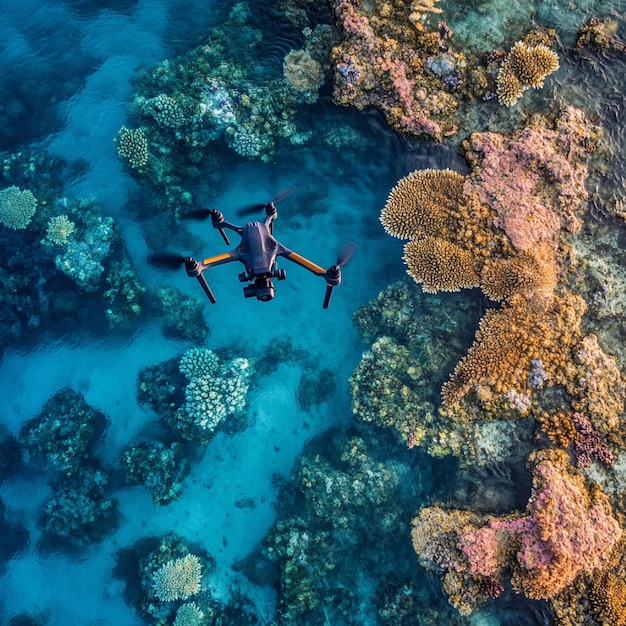
Remote sensing and drone technology
Satellites and drones provide invaluable tools for mapping and monitoring vast coastal areas that are difficult to access manually. Satellite imagery can track changes in coastline morphology, monitor seagrass beds, detect oil spills, and assess the extent of harmful algal blooms over large scales. Drones offer higher resolution imagery and can be deployed quickly for localized surveys, such as monitoring wildlife populations, documenting erosion patterns, or assessing post-storm damage.
The data collected from these platforms can be used to inform policy decisions, identify areas needing restoration, and track the effectiveness of conservation interventions. For example, drone surveys can accurately count nesting bird populations or map invasive species spread, providing crucial information for targeted management actions. The ability to collect data repeatedly and consistently helps in understanding long-term trends.
Artificial intelligence and data analytics
The sheer volume of data collected in conservation efforts can be overwhelming. Artificial intelligence (AI) and machine learning algorithms are being employed to process and analyze this data efficiently, identifying patterns and making predictions. AI can help in species identification from camera trap footage, tracking animal movements through tagging data, or forecasting environmental changes like sea-level rise impacts.
- Automated species identification from images and acoustic data.
- Predictive modeling for habitat change and species distribution.
- Optimizing patrol routes for anti-poaching and enforcement efforts.
Big data analytics allows conservationists to combine diverse datasets—from oceanographic data to socio-economic information—to gain a holistic understanding of complex coastal challenges. This enables more informed decision-making and the development of targeted, evidence-based conservation strategies. AI-powered tools can also assist in detecting illegal fishing activities or monitoring compliance with environmental regulations.
Acoustic monitoring and eDNA
Hydrophones underwater sensors are revolutionizing the study of marine life by listening to the sounds of the ocean. Acoustic monitoring can detect the presence of marine mammals, track their movements, and identify their communication patterns without disturbing them. This is particularly useful for elusive species or those in deep waters, providing insights into their behavior and habitat use.
Environmental DNA (eDNA) is another groundbreaking technology. Organisms shed DNA into their environment (e.g., skin cells, waste). By collecting water samples and analyzing the eDNA present, scientists can detect the presence of species without needing to physically observe or capture them. This non-invasive method allows for early detection of rare or invasive species, and provides a cost-effective way to survey biodiversity in large areas.
The integration of these technologies—from sensor networks to genetic analysis—provides conservationists with powerful tools to understand, monitor, and protect coastal ecosystems in ways previously unimaginable. As these technologies continue to evolve, they will play an increasingly vital role in ensuring the long-term health and resilience of our invaluable coastal environments.
Addressing climate change impacts on coastal zones
Climate change poses perhaps the most profound and far-reaching threat to coastal conservation efforts: protecting endangered species and habitats. Its impacts, including rising sea levels, ocean acidification, and more extreme weather events, directly undermine the ecological integrity and resilience of coastal zones. Addressing these impacts requires a dual approach of mitigation (reducing greenhouse gas emissions) and adaptation (adjusting to the changes that are already occurring).
Sea-level rise and coastal squeeze
As global temperatures rise, glaciers and ice sheets melt, and ocean waters expand, leading to a relentless increase in sea levels. This directly threatens low-lying coastal habitats such as salt marshes, mangroves, and beaches. For many species reliant on these habitats, rising waters can lead to “coastal squeeze,” where habitats are constrained between the encroaching sea and human development upstream, leaving no room for natural migration.
Adaptation strategies include “managed retreat,” selectively relocating infrastructure away from vulnerable coastlines to allow natural habitats to migrate inland. Another approach is “living shorelines,” which use natural materials like plants, shells, and sand to stabilize coastlines and provide habitat, rather than rigid seawalls that often exacerbate erosion and eliminate natural shoreline processes. These natural solutions are often more sustainable and ecologically beneficial.
Ocean acidification: A silent threat
The increasing absorption of atmospheric carbon dioxide by the oceans is leading to ocean acidification, lowering the pH of seawater. This is particularly detrimental to organisms that build shells or skeletons from calcium carbonate, such as corals, shellfish, and certain plankton. As ocean chemistry changes, these organisms struggle to form and maintain their structures, threatening entire food webs.
Mitigating ocean acidification primarily requires a global reduction in CO2 emissions, as it is a systemic problem. Locally, efforts to reduce nutrient pollution can help, as eutrophication can exacerbate acidification in coastal waters. Research into more resilient coral and shellfish species also offers potential avenues for adaptation, though these are long-term solutions.
- Reducing global CO2 emissions is paramount to slowing ocean acidification.
- Minimize local pollution to alleviate additional stress on marine organisms.
- Invest in research for developing more resilient marine species.
Extreme weather events and their consequences
Climate change is increasing the frequency and intensity of extreme weather events, including hurricanes, storm surges, and heatwaves. These events cause significant physical damage to coastal habitats, leading to widespread erosion, destruction of coral reefs and seagrass beds, and displacement of wildlife. Saltwater intrusion into freshwater ecosystems also becomes more frequent, altering delicate balances.
Building coastal resilience involves strengthening natural defenses like wetlands and barrier islands, which can absorb storm energy. Planning for disaster recovery and implementing early warning systems are also crucial. Ecosystem-based adaptation (EbA) approaches integrate biodiversity and ecosystem services into adaptation plans, using natural solutions to reduce climate risks, such as restoring mangroves to protect against storm surge.
Addressing climate change in coastal zones requires urgent action at both global and local scales. While large-scale emission reductions are essential to mitigate the root cause, immediate adaptation measures are necessary to protect vulnerable communities and ecosystems from the impacts that are already unfolding. The future of coastal conservation depends on our ability to respond effectively to these evolving climate threats.
The role of policy and international cooperation
Effective coastal conservation efforts: protecting endangered species and habitats fundamentally rely on robust policy frameworks and strong international cooperation. Environmental challenges, particularly in coastal and marine environments, often transcend political boundaries, necessitating coordinated action and shared responsibility. Policies provide the legal and regulatory backbone, while cooperation facilitates knowledge exchange and collective impact.
National and sub-national policies
At the national level, laws such as the Endangered Species Act in the US provide critical protection for vulnerable species and their habitats. Coastal Zone Management programs encourage states to develop comprehensive plans for managing their coastal resources sustainably, balancing conservation with economic development. These policies often involve zoning regulations, permitting processes for development, and water quality standards.
State and local governments play a crucial role in implementing these policies, often adapting them to specific regional needs. This includes developing local ordinances for shoreline protection, managing stormwater runoff, and establishing community-driven conservation initiatives. The effectiveness of these policies depends on adequate funding, scientific understanding, and consistent enforcement.
International conventions and agreements
Many threats to coastal and marine environments are transboundary. Pollution from one country can affect the coastal waters of another, and migratory species cross numerous national jurisdictions. International conventions, such as the Convention on Biological Diversity (CBD) and the Ramsar Convention on Wetlands, provide frameworks for countries to work together on conservation goals. Regional agreements, like those focused on specific sea basins (e.g., the Caribbean Sea), address shared environmental challenges.
These agreements facilitate the protection of shared resources, coordinate research efforts, and promote best practices. They often involve setting common goals for reducing pollution, managing shared fish stocks, and establishing transboundary protected areas. While non-binding in some cases, these conventions serve as powerful tools for encouraging international collaboration and raising global awareness.
- UNCLOS (United Nations Convention on the Law of the Sea): Establishes legal framework for marine activities.
- CBD (Convention on Biological Diversity): Aims to conserve biodiversity, sustainable use, and fair sharing of benefits.
- Ramsar Convention: Focuses on wetlands of international importance, especially as waterfowl habitat.
- CITES (Convention on International Trade in Endangered Species): Regulates trade in threatened species.
Financing conservation efforts
Sustainable financing is a critical component of successful policy implementation. Conservation initiatives, whether for habitat restoration, species protection, or policy enforcement, require significant resources. Funding can come from government budgets, philanthropic organizations, international aid, and innovative mechanisms like carbon credits or ecotourism revenues. Public-private partnerships are also increasingly important in mobilizing the necessary capital.
Ensuring transparent and efficient allocation of funds is key to maximizing their impact. Long-term financial sustainability plans help ensure that conservation efforts can continue for decades, rather than being limited by short-term project cycles. This includes investing in the capacity building for local communities and institutions to manage their own conservation programs.
The interplay of strong policy, cross-border collaboration, and sustainable financing creates a robust framework for addressing the complex challenges facing coastal ecosystems globally. Without these pillars, even the most innovative local projects will struggle to achieve lasting, widespread impact, underscoring the interconnectedness of governance and environmental health.
Future outlook and sustainable practices
The future of coastal conservation efforts: protecting endangered species and habitats depends on our collective ability to scale up sustainable practices and embrace a long-term vision. While significant challenges remain, there is also growing awareness and innovation in addressing these critical issues. Moving forward, the focus must be on integrating conservation into all aspects of coastal management and fostering a deeper connection between humans and the marine environment.
Ecosystem-based management (EBM)
Ecosystem-based management (EBM) is a holistic approach that considers the entire ecosystem, including humans, in guiding management decisions for coastal and marine environments. Unlike traditional sector-by-sector management (e.g., managing fisheries separately from water quality), EBM acknowledges the interconnectedness of all components. This leads to more integrated solutions that aim to maintain ecosystem health and resilience while supporting human well-being.
Implementing EBM involves robust scientific understanding, collaborative governance structures, and adaptive management principles. It requires managers to consider cumulative impacts of various activities, prioritize ecosystem health, and involve diverse stakeholders in the decision-making process. The goal is to move beyond simply protecting individual species or habitats to managing entire systems sustainably.
Green infrastructure and nature-based solutions
There is a growing recognition of the value of “green infrastructure” or “nature-based solutions” as alternatives to conventional grey infrastructure (like seawalls and levees). Restoring and protecting natural coastal features such as mangroves, salt marshes, dunes, and oyster reefs can provide superior long-term benefits. These natural systems offer coastal protection, enhance biodiversity, improve water quality, and sequester carbon, often at lower costs than engineered solutions.
Investing in nature-based solutions supports both conservation and human resilience to climate change impacts. For example, healthy mangrove forests can dissipate wave energy, reducing storm surge impacts on coastal communities. Promoting these solutions requires shifting policy and funding priorities away from traditional engineering and towards ecological restoration and preservation.
Individual action and consumer choices
While large-scale policy and systemic changes are crucial, individual actions also play a vital role. Everyday consumer choices, such as choosing sustainably sourced seafood, reducing plastic consumption, and supporting businesses committed to environmental responsibility, can create significant collective impact. Participating in beach cleanups, advocating for strong environmental policies, and educating others also contribute to broader conservation goals.
- Support sustainable seafood choices certified by reputable organizations.
- Reduce plastic usage; opt for reusable alternatives and proper recycling.
- Participate in local conservation initiatives, such as beach cleanups or citizen science.
- Advocate for and vote in favor of strong environmental policies and funding.
Ultimately, the long-term success of coastal conservation lies in fostering a deeper understanding and appreciation for these invaluable ecosystems across all segments of society. By combining scientific innovation, robust policies, holistic management, and engaged communities, we can work towards a future where coastal areas thrive, supporting both vibrant biodiversity and resilient human populations for generations to come. The goal is not just to protect, but to live in harmony with our coastal environments.
| Key Point | Brief Description |
|---|---|
| 🌎 Habitat Loss | Coastal development and pollution are destroying vital marine habitats and affecting species survival. |
| 🐢 Species Protection | Targeted efforts protect endangered species like sea turtles and manatees through habitat preservation and reducing threats. |
| 🔬 Tech & Policy | Innovative tech (AI, drones) and strong policies (MPAs, international agreements) bolster conservation initiatives. |
| 📈 Climate Resilience | Adaptation to climate change, using nature-based solutions, is crucial for long-term coastal health. |
Frequently asked questions about coastal conservation
▼
Coastal ecosystems are vital because they provide critical habitats for diverse species, protect shorelines from storms, filter pollutants, and support significant economic activities like fisheries and tourism. They regulate climate, cycle nutrients, and offer recreational opportunities, making their health essential for both ecological balance and human well-being.
▼
Marine Protected Areas (MPAs) are designated zones in oceans, estuaries, or Great Lakes where human activities are restricted to protect specific marine resources. They help by creating safe havens for marine life, allowing endangered species to recover, increasing biodiversity, and often replenishing fish stocks in surrounding areas through spillover effects.
▼
Climate change significantly impacts coastal conservation through rising sea levels, which inundate habitats; ocean acidification, harming shell-forming organisms; and increased intensity of storms, causing physical damage and erosion. These changes stress ecosystems, making species more vulnerable and hindering recovery efforts, necessitating adaptation strategies.
▼
Individuals can contribute significantly by supporting sustainable seafood, reducing single-use plastics, participating in beach cleanups, and advocating for stronger environmental policies. Learning about coastal issues, adjusting personal consumption habits, and volunteering with conservation organizations all play a part in fostering a culture of stewardship and protecting coastal health.
▼
Nature-based solutions leverage natural processes and ecosystems to address environmental challenges. In coastal conservation, this means restoring or protecting features like mangroves, salt marshes, and oyster reefs to provide services such as coastal protection, water filtration, and habitat creation, often being more sustainable and cost-effective than engineered structures.
Conclusion
The imperative for robust coastal conservation efforts becomes clearer with each passing year. The intricate web of life sustained by our coastlines is under immense pressure, yet the dedication to protect these invaluable ecosystems is growing. By integrating scientific innovation, enacting well-crafted policies, fostering international cooperation, and empowering communities, we can build a more resilient future for endangered species and their vital habitats. The health of our coasts is not merely an environmental concern; it is fundamental to the well-being of our planet and generations to come.

